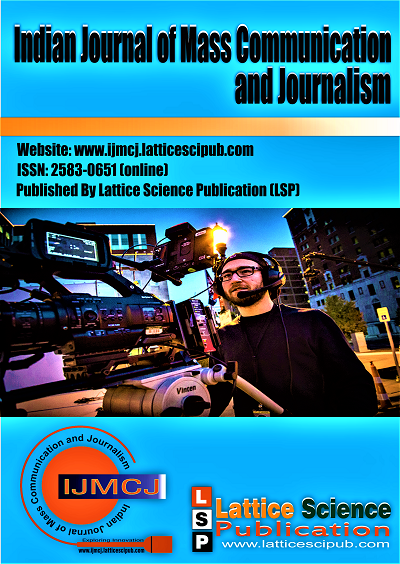Analysis of Single-Shot and Long-Take Filmmaking: Its Evolution, Technique, Mise-en-scène, and Impact on the Viewer
Main Article Content
Abstract
The most of the narrative films feature extremely deliberate movie editing. The tale is advanced and viewers are given a feeling of time through cuts between shots. Cutaway shots provide background, and quick cuts that take place in only a fraction of a second, give the project vitality. A longer take, on the other hand, can occasionally be used to tell the story and transmit a lot of information at once, making it a crucial cinematography technique. Long-takes used to be constrained by the amount of physical film that could fit inside a camera. However, since everything is now done digitally, we can shoot as much as our multi-gigabyte storage card desires. There are several movie scenes that employ this long-take technique, but much fewer movies attempt to shoot the entire thing in a single take, and these films should be commended for taking the risk, even if they had various degrees of success. A single-shot or a long-take movie gives the illusion that time and space are continuous, just like in real life. So, as long as the filmmakers feel the need to be innovative and try to achieve something that is more difficult and fascinating for their films, innovation will remain crucial in the film industry. The one-shot technique is a rare example of a creative, innovative, and difficult technique. Using case studies, news reports and literature reviews, this study carefully observes that because the camera moves through and rewrites space in a single-shot movie, this filmmaking technique significantly contributes to the development of its mise-en-scène. It examines the effects that a single-shot or a long-take movie creates among the audience and the technical manoeuvres that define the success of it.
Downloads
Article Details

This work is licensed under a Creative Commons Attribution-NonCommercial-NoDerivatives 4.0 International License.
How to Cite
References
Yuri Tsivian, in The Griffith Project: Vol. 9: Films Produced in 1916–1918, Paolo Cherchi Usai (ed.), text at Cinemetrics.
Bazin, André. “The Evolution of the Language of Cinema.” What Is Cinema? Volume 1. 23-40.
Thompson, K. (2004) ‘The Concept of Cinematic Excess’, in Film Theory and Criticism: Introductory Readings, edited by Leo Braudy & Marshall Cohen, 513-24. New York & Oxford: Oxford U.P.
"Bazin Andre What Is Cinema Volume 1". p. 33 – via Internet Archive.
Bordwell, David. 1983. Mizoguchi and the evolution of film language. In Cinema and Language., eds. Stephen Heath, Patricia Mellencamp,
-117. University Publications of America, AFI.
Salt, Barry. Film Style and Technology: History and Analysis. London: Starword, 1992.
Deakins, Roger. https://www.youtube.com/watch?v=7uwjS7d4ntA Studiobinder. 06 July 2020.
Kolker, Robert. "Mise-En-Scène." 2019. Encyclopedia.com. <https://www.encyclopedia.com/arts/encyclopedias-almanacs-transcrip
ts-and-maps/mise-en-scene>
Deguzaman, Kyle. "1917 One Shot Explained — How Roger Deakins Shot a “Oner” Film." 05 July 2020. Studiobinder. <https://www.studiobinder.com/blog/1917-one-shot-cinematography/>
Fisher, Kieran and Kieran Fisher . "A Brief History of One-Shot Films." 17 December 2019. Film School Rejects. <https://filmschoolrejects.com/one-shot-films/>.
Wavefilmmakers. "The single shot, the differences of the long take, and its effects in the viewer." n.d. Wavefilmmakers.
<https://wavefilmakers.com/the-single-shot-and-its-effects-in-the-viewer/>.
Wiki, Ultimate Pop Culture. "Long take." n.d. Ultimate Pop Culture Wiki. <https://ultimatepopculture.fandom.com/wiki/Long_take>.
Harrison, Ellie. "‘For take two, those knuckleheads took MDMA’: Inside the chaotic world of one-shot films." 02 January 2022.
Independent. <https://www.independent.co.uk/arts-entertainment/films/features/oneshot-movies-boiling-point-victoria-b1985593.html>





